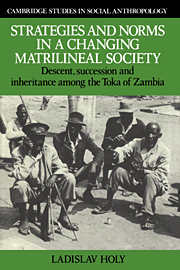 Strategies and Norms in a Changing Matrilineal Society
Strategies and Norms in a Changing Matrilineal Society Published online by Cambridge University Press: 25 August 2009
One of the important consequences of the introduction of new agricultural technology and the resulting restructuring of the relations of production in Ngwezi has been a decrease in the inter-village mobility of the male population. This has led to considerable changes in the social composition of existing villages.
Individual mobility
My study of individual mobility in Ngwezi is based on a census of 119 married, divorced, or widowed men and 134 married, divorced or widowed women in twelve villages. To indicate the changes which have occurred, I compare it with individual mobility in Cifokoboyo, whose analysis is based on a census of 114 married, divorced, or widowed men and 120 married, divorced or widowed women in eleven villages in that area.
At the time of the census, sixteen women in Ngwezi resided in their natal villages. Nine of them had never left the village in which they were born and another seven returned to it after they had temporarily established residence elsewhere. (In Table 2 women who had moved back to their natal villages appear as residing in their third or fourth village.) It is quite typical that a divorcee returns to the village of her parents, which does not necessarily have to be her natal village. It is sometimes a village into which her parents (or her mother) have themselves moved from the village in which she was born.
To save this book to your Kindle, first ensure [email protected] is added to your Approved Personal Document E-mail List under your Personal Document Settings on the Manage Your Content and Devices page of your Amazon account. Then enter the ‘name’ part of your Kindle email address below. Find out more about saving to your Kindle.
Note you can select to save to either the @free.kindle.com or @kindle.com variations. ‘@free.kindle.com’ emails are free but can only be saved to your device when it is connected to wi-fi. ‘@kindle.com’ emails can be delivered even when you are not connected to wi-fi, but note that service fees apply.
Find out more about the Kindle Personal Document Service.
To save content items to your account, please confirm that you agree to abide by our usage policies. If this is the first time you use this feature, you will be asked to authorise Cambridge Core to connect with your account. Find out more about saving content to Dropbox.
To save content items to your account, please confirm that you agree to abide by our usage policies. If this is the first time you use this feature, you will be asked to authorise Cambridge Core to connect with your account. Find out more about saving content to Google Drive.